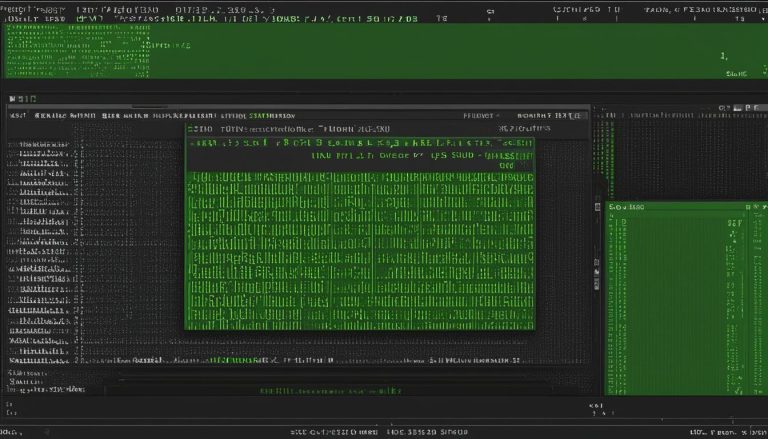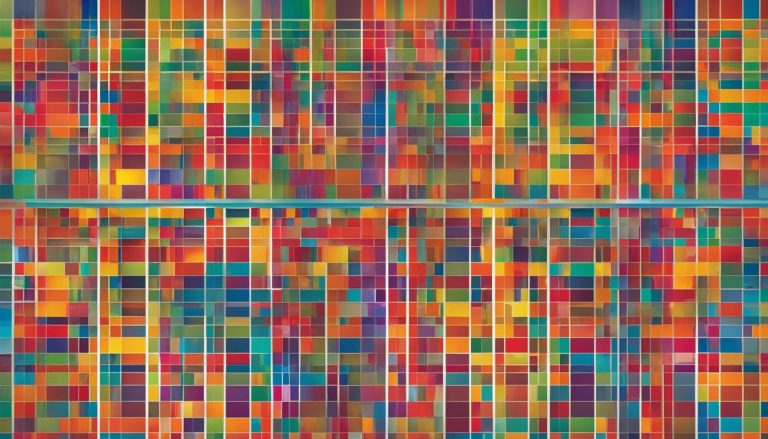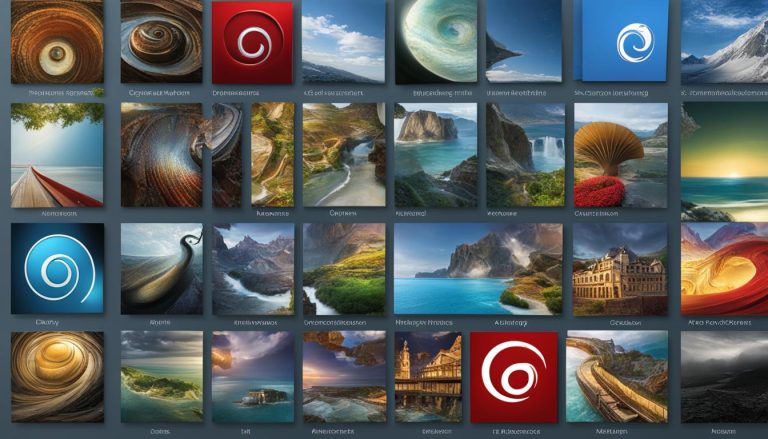Welcome to my comprehensive guide on the X Window System, also known as X11. In this article, we will dive deep into the world of X Window and explore its architecture, functionalities, and significance in the Unix-like operating systems.
The X Window System is a windowing system that provides a graphical user interface framework for Unix-like operating systems. It allows users to interact with the display, move windows, and utilize input devices such as a mouse and keyboard. X originated from MIT’s Project Athena in 1984 and has since become widely adopted, with X11 being the current version.
The X Window System follows a client/server model, where the X server controls the display and input devices, while X clients run applications that communicate with the server. This architecture allows for network transparency, enabling users to display their interfaces on remote X servers.
When it comes to practical usage, the X Window System handles various input devices like keyboards, mice, touchpads, and touchscreens. It also provides support for advanced input techniques such as multitouch. On the output side, X supports rendering and rasterization of graphics, allowing for the creation of visually appealing interfaces.
Overall, the X Window System is a powerful and flexible framework that has been developed by the X.Org Foundation over the years. Its features and history make it an essential component of Unix-like operating systems, providing a foundation for graphical applications and environments.
Key Takeaways:
- The X Window System, also known as X11, is a windowing system used on Unix-like operating systems.
- X follows a client/server model, with the X server controlling the display and input devices.
- X supports network transparency, allowing for remote display of user interfaces.
- The X Window System handles input devices like keyboards, mice, and touchscreens.
- X provides rendering and rasterization capabilities for graphics.
X Is Client / Server
The X Window System follows a client/server model, with the X server being the central component. The X server, running on the local machine, controls the display and input devices such as keyboards and mice. It acts as the endpoint for all client applications, providing them with access to the hardware devices. The X server can handle multiple clients simultaneously and typically runs longer than most client applications.
X clients, on the other hand, are the applications that run on the same computer as the X server or connect to a server on a different machine over a network. They communicate with the X server to display their user interfaces and handle input events from keyboards and mice. The X server manages the input from these devices and ensures that the corresponding events are sent to the appropriate clients.
This client/server architecture of the X Window System enables the separation of the user interface and the underlying display system. It allows for the flexibility of running applications on different machines while displaying their interfaces on a local X server. This feature, known as network transparency, is particularly useful for remote access scenarios and contributes to the versatility of the X Window System.
X Server
The X server is responsible for controlling the display and input devices on the local machine. It provides access to the hardware devices and handles input events from keyboards and mice. The X server supports multiple clients and manages the display of their user interfaces.
X Clients
X clients are the applications that run on the same computer as the X server or connect to a server on a different machine. They communicate with the X server to display their user interfaces and handle input events from keyboards and mice.
Network Transparency
The client/server architecture of the X Window System enables network transparency, allowing clients to display their user interfaces on a remote X server. This feature is particularly useful for scenarios where applications need to be accessed and used remotely.
X In Practice
In practice, the X Window System is a versatile platform that handles input devices and output devices. It facilitates user interactions through various input devices such as keyboards, mice, touchpads, and touchscreens. The X server, which runs on the local machine, is responsible for handling these input devices and sending corresponding events to the appropriate client applications.
Keyboards play a vital role in the X Window System, as the X server captures key events and forwards them to the respective clients. Different types of keyboards with their unique keycodes and KeySyms are supported by the X server. This enables users to type on their keyboards and have the input reflected in the client applications seamlessly.
The X server also supports pointer devices, such as mice, allowing users to control the cursor on the screen. Applications can customize the appearance and behavior of the cursor, enhancing the user experience. Additionally, the X Window System supports advanced input devices like multitouch on touchpads and touchscreens, expanding the range of interactions possible.
Table: Input Devices Supported by the X Window System
| Input Device | Description |
|---|---|
| Keyboard | Enables typing and key events |
| Mouse | Controls the cursor on the screen |
| Touchpad | Supports multitouch interactions |
| Touchscreen | Enables touch-based interactions |
The X server also keeps track of the elements drawn on the display and can request clients to redraw if necessary. This ensures that the content displayed remains up to date and accurate. Additionally, the X server provides a GetImage request, allowing clients to read back the contents of the frame buffer directly. This feature enables applications to access the visual representation of the display, which can be useful for various purposes.
Overall, the X Window System’s ability to handle input devices and manage the display makes it a powerful platform for building graphical user interfaces. Its support for various input devices and advanced techniques enhances the user experience, while its flexibility allows for the creation of diverse and customizable environments.
I’ve always been impressed by the versatility of the X Window System. It seamlessly handles different input devices, from traditional keyboards and mice to modern touchscreens. The ability to customize the appearance and behavior of the cursor adds a nice touch to the user experience. Plus, with the X server keeping track of what’s displayed on the screen and the GetImage request, applications have even more control over the visual elements. It’s truly a powerful system for building graphical interfaces.
Output and Rendering
The X Window System provides a comprehensive framework for output and rendering of graphics. From basic primitive rendering operations like line drawing and polygon filling to more advanced graphics, the X Window System supports a wide range of rendering capabilities. Modern applications often utilize client-side rendering libraries like Cairo or OpenGL for more sophisticated graphics.
In the X Window System, resources are divided into displays and screens. A display encompasses all the devices connected to a single X server, while a screen is a subset of the display on which windows can be displayed or moved. It’s important to note that windows cannot span across multiple screens in X. This division of resources allows for efficient management and allocation of graphical elements.
To further enhance the visual presentation and control of graphics, X utilizes a concept called graphics contexts. Graphics contexts are associated with a specific window or drawable and define attributes such as colors, fonts, and line styles. By utilizing graphics contexts, developers have fine-grained control over the appearance and behavior of graphics within their applications.
Displays and Screens
Let’s take a closer look at how the X Window System handles displays and screens:
| Display | Screen |
|---|---|
| A display represents a collection of devices connected to a single X server. | A screen is a subset of the display on which windows can be displayed or moved. |
| Displays can include multiple screens, each with its own set of resources. | Screens have a unique identifier and can be managed independently. |
| Multiple clients can connect to a single display, allowing for concurrent usage. | Screens can have different resolutions, color depths, and other attributes. |
By separating displays and screens, the X Window System provides a flexible and scalable environment for creating graphical user interfaces. Developers can leverage this architecture to create visually engaging applications that seamlessly integrate with the overall user experience.
In the X Window System, the appearance and behavior of windows and graphics are controlled by window managers and desktop environments. This allows for a customizable user experience, with the ability to personalize the look and feel of the graphical interface. Window managers provide features such as window decorations, title bars, and minimize/maximize/close buttons, while desktop environments offer a complete set of tools and applications for a cohesive user experience.
Conclusion
The X Window System is a powerful and versatile windowing system used on Unix-like operating systems. It provides a comprehensive framework for creating graphical user interfaces, enabling users to interact with their displays, move windows, and use input devices such as mice and keyboards. With its network transparency feature, X allows clients to display their user interfaces on remote X servers, offering remote access capabilities.
X has a rich history, originating from Project Athena at MIT in 1984. Since then, it has been continuously developed and led by the X.Org Foundation, with the current reference implementation being X.Org Server. Throughout its evolution, the X Window System has remained a popular choice for Unix-like operating systems, appreciated for its flexibility, robustness, and extensive feature set.
The X Window System architecture supports a wide range of features, including input handling for keyboards, mice, touchpads, and touchscreens. It also enables rendering and rasterization of graphics, providing a foundation for building visually appealing graphical applications. While X itself does not dictate the user interface design, window managers and desktop environments can further enhance the appearance and behavior of X-based environments.
In conclusion, the X Window System’s enduring presence in the Unix-like operating system landscape is a testament to its capabilities and adaptability. With its rich history and extensive feature set, it continues to serve as a foundational component for graphical applications, ensuring a seamless and user-friendly experience for millions of users worldwide.
FAQ
What is the X Window System?
The X Window System, also known as X11, is a windowing system used on Unix-like operating systems. It provides the framework for a graphical user interface, allowing users to interact with the display, move windows, and use input devices such as a mouse and keyboard.
How does the X Window System work?
The X Window System follows a client/server model. The X server controls the display and input devices, while X clients run applications that communicate with the server. The server provides access to hardware devices and manages input from keyboards and mice.
Can X clients run on a different machine than the X server?
Yes, X clients can connect to a server on a different machine over a network. This feature allows for remote access to graphical user interfaces.
What kind of input devices does the X Window System support?
The X Window System supports various input devices, including keyboards, mice, touchpads, and touchscreens. It can handle typing on keyboards, send key events to applications, and control cursor movement based on mouse or similar device input.
How does X handle graphics rendering?
X provides basic rendering operations like line drawing and polygon filling. However, modern applications often use client-side rendering libraries such as Cairo or OpenGL for more advanced graphics. X divides resources into displays and screens, with screens being subsets of displays on which windows can be displayed or moved.
Hi, I’m Mark, the author of Clever IT Solutions: Mastering Technology for Success. I am passionate about empowering individuals to navigate the ever-changing world of information technology. With years of experience in the industry, I have honed my skills and knowledge to share with you. At Clever IT Solutions, we are dedicated to teaching you how to tackle any IT challenge, helping you stay ahead in today’s digital world. From troubleshooting common issues to mastering complex technologies, I am here to guide you every step of the way. Join me on this journey as we unlock the secrets to IT success.


